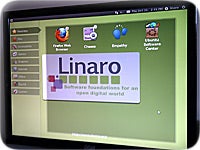

Linaro is ramping up its efforts to get ARM more deeply embedded into mainstream enterprise computing.
Linaro is a non-profit organization that is helping to organize and lead Linux server development on ARM. This past week, multiple vendors joined Linaro, including AMD, AppliedMicro, Calxeda, Canonical, Cavium, Facebook, HP, Marvell and Red Hat, to create a new working group called the Linaro Enterprise Group (LEG).
David Rusling, CTO of Linaro, told ServerWatch that in contrast to other Linaro efforts, the scope of the new enterprise group is more constrained. He noted that the work LEG will do adds to the core work that the organization is already doing.
Some of the new work LEG is doing deals with boot architecture, including UEFI, security and virtualization. The group is also looking at sets of libraries and languages that ARM, in the mobile space, has not been particularly focused on.
“I’m confident that LEG is off to a good start,” Rusling said. In addition to “various technical sessions, the engineering management team met and worked really hard on getting this up and running. “
 Rusling added that some engineers are already working in LEG, and the aim is to ramp the teams as quickly as possible and start producing results.
Rusling added that some engineers are already working in LEG, and the aim is to ramp the teams as quickly as possible and start producing results.
A big change for the Linaro community is coming with the pending release of the Linux 3.7 kernel. The Linux 3.7 kernel will be the first to provide uniform support for the ARM architecture.
From a Linaro perspective Rusling noted that the Linux 3.7 kernel represents some solid consolidation work and great strides in power management.
“I want to continue to help ARM be an exemplary member of the open source community, particularly in Linux,” Rusling said.
One of the biggest challenges facing Linux on ARM has to do with something known as big.LITTLE MP. With big.LITTLE MP, there are a pair of cluster ARM Cortex-A15 and A-7 cores joined together. In the big.LITTLE MP model all those ARM cores work together in a single Linux kernel instance.
“Technically, it’s a challenge to support big.LITTLE MP,” Rusling said. “We’ve made great strides, but we need to modify several areas of the kernel changing, including scheduling. It will take a concerted effort to instrument its operation and tune it for real world products.”
Rusling described the challenge as a “heavy lifting engineering problem” of the sort that Linaro loves to tackle.
“We, and the ARM partners, can do this, but it’ll take effort and coordination,” Rusling said.
There are also other, non-technical challenges that Linaro must deal with in advancing Linux on ARM.
“Project management of open source work is difficult, particularly if you add the coordination with our members and their product plans,” Rusling said. “Luckily, I’m seeing great project management in Linaro. They’re using some innovative techniques and setting a high standard.”
Sean Michael Kerner is a senior editor at InternetNews.com, the news service of the IT Business Edge Network, the network for technology professionals Follow him on Twitter @TechJournalist.
Property of TechnologyAdvice. © 2025 TechnologyAdvice. All Rights Reserved
Advertiser Disclosure: Some of the products that appear on this site are from companies from which TechnologyAdvice receives compensation. This compensation may impact how and where products appear on this site including, for example, the order in which they appear. TechnologyAdvice does not include all companies or all types of products available in the marketplace.